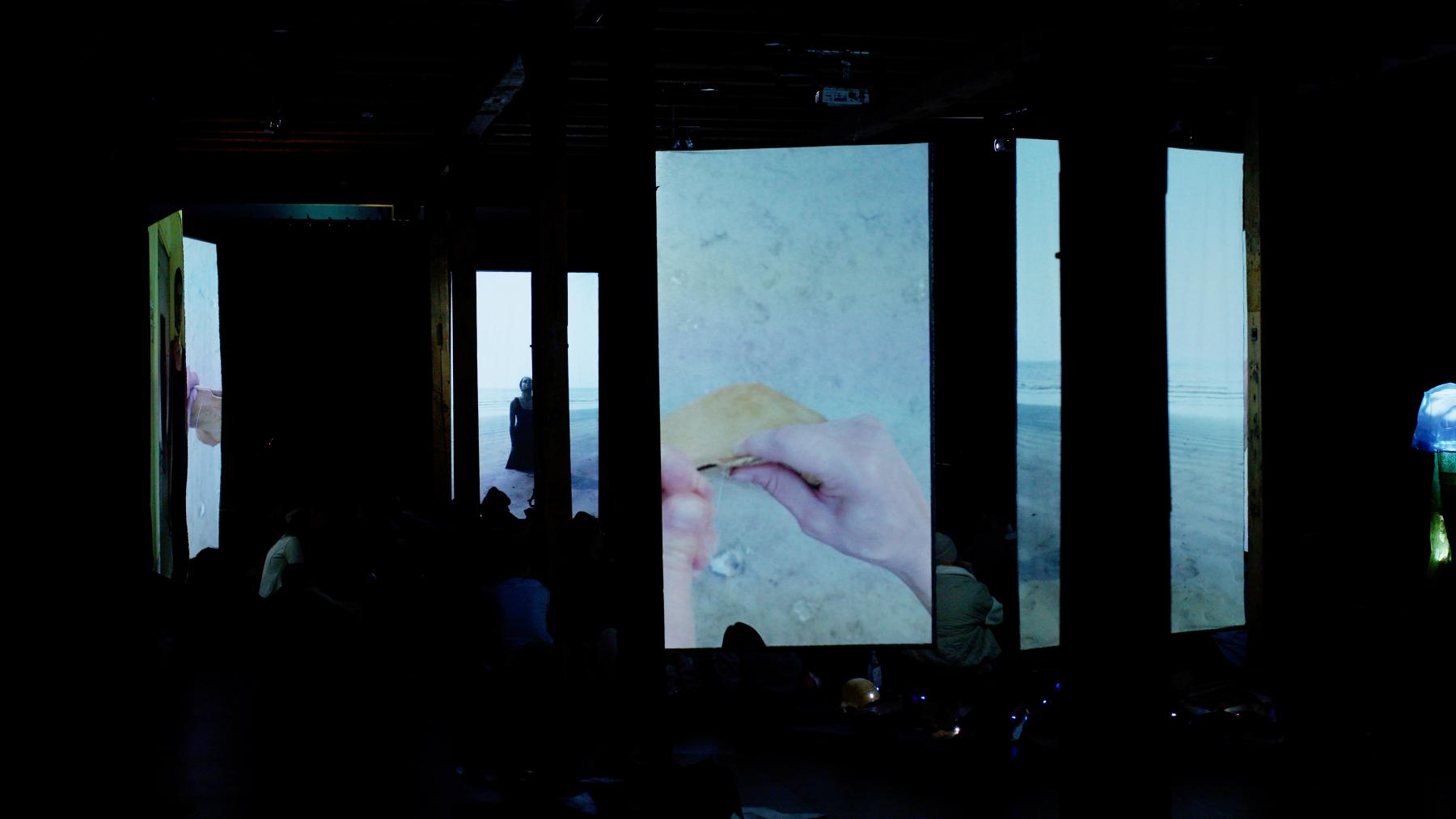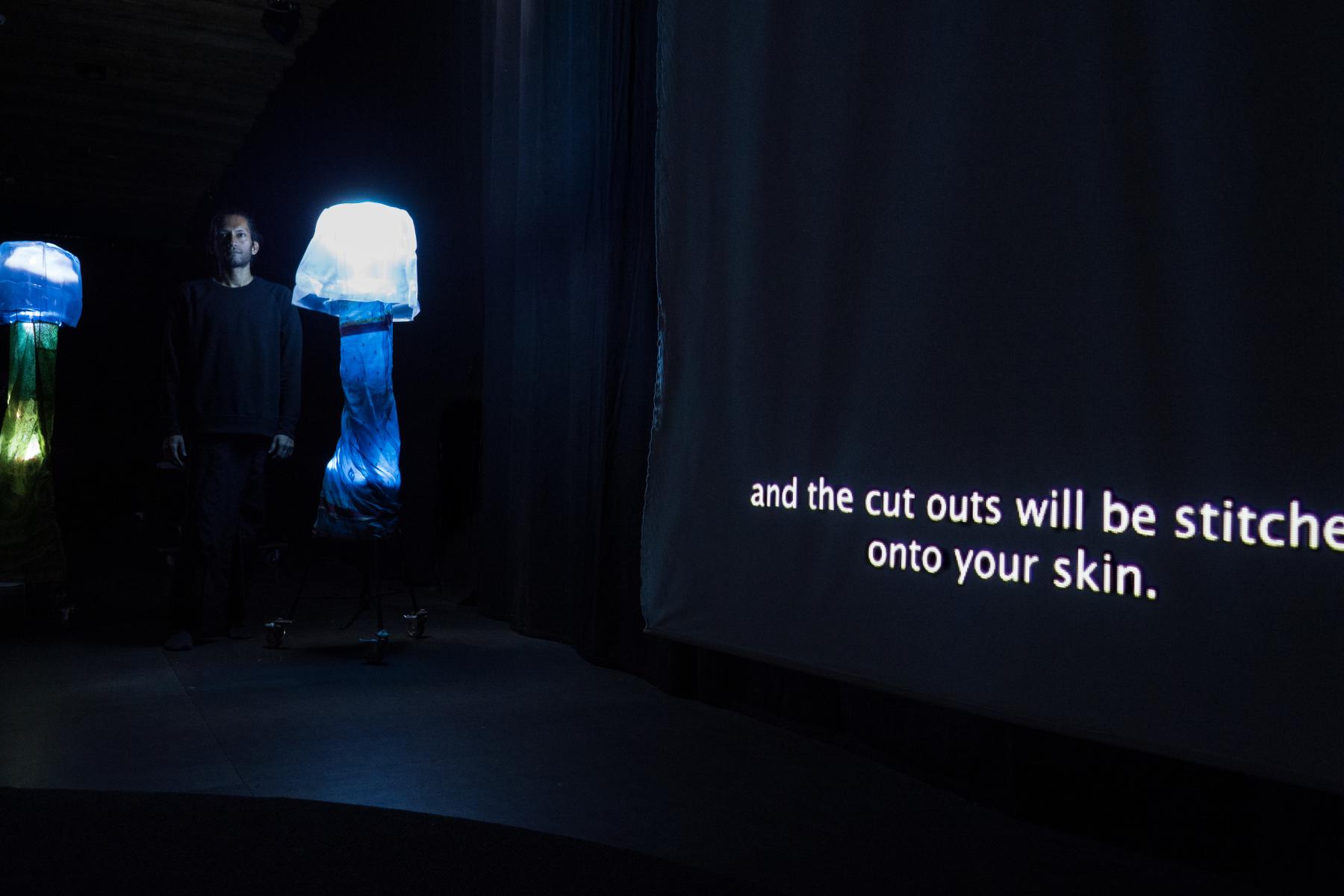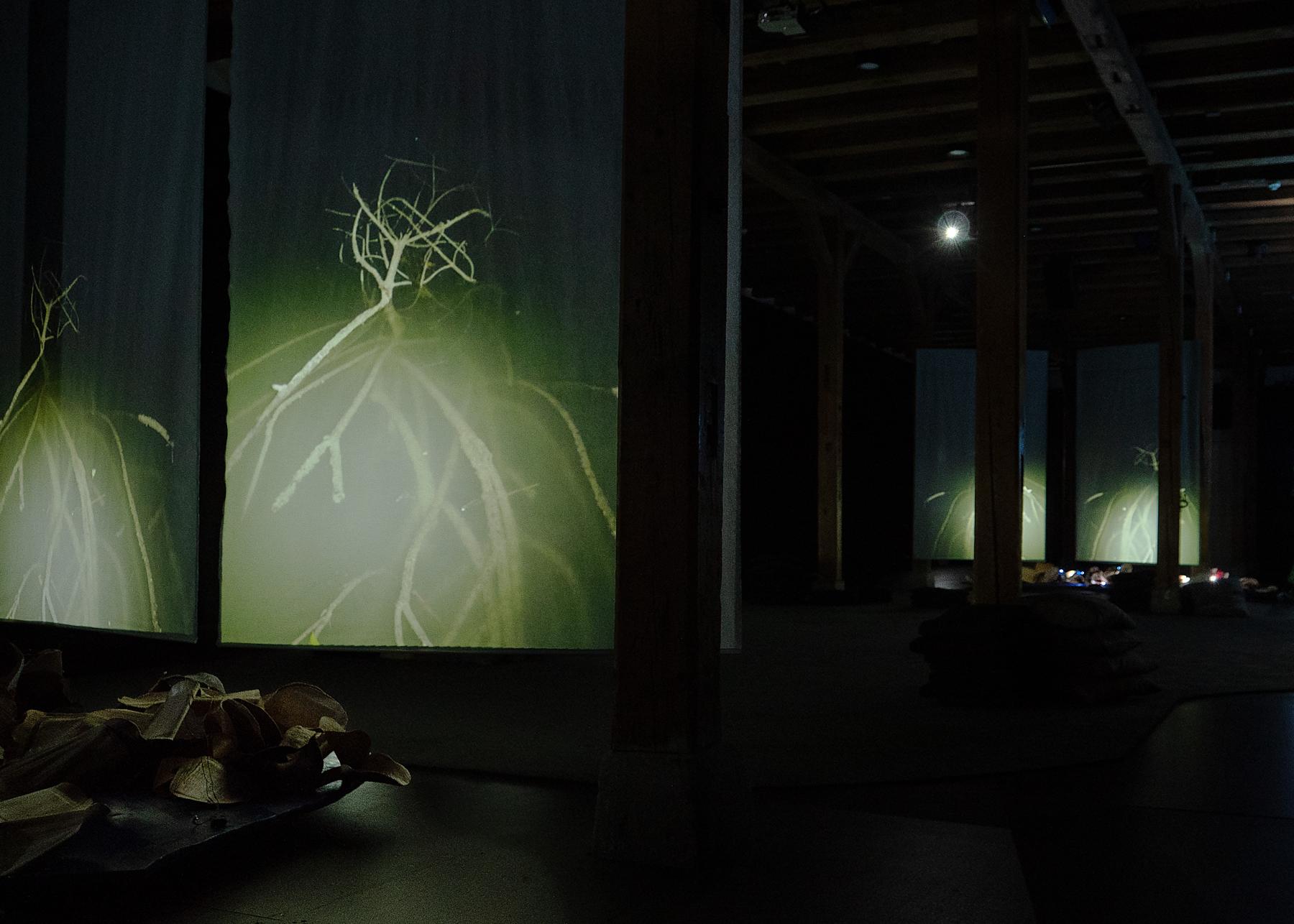Technotropies of the Otherwise: A Reading in Submergence
A circular arrangement of eight screens invites the viewer to station themselves within its perimeters. Seated on the floor in a darkened room, one hears amplified gulps before encountering the enacting bodies. Appearing in tandem and flitting across the screens, they perform an exteriorised breathing: air is aggressively exhaled with every chug of bottled water, almost as an urgent exercise in survival.

Staged at the Theaterhaus Gessneralle, Zurich, from 30 March to 6 April 2023, Technotropies of the Otherwise by artists Stefanie Knobel and Samrat Banerjee is simultaneously a performance, film and installation that draws the viewer into an immersive pocket simulating aquatic textures. At one point, the viewer is presented with a crafty manoeuvre in supari pata (areca palm leaves), which are sutured to create flaps resembling gills. This device is introduced as an evolutionary adjunct; labelled an “organ”, it is grown, harvested and subsequently attached to human skin to help them breathe underwater. Through these additive techniques, the work actively speculates on an oceanic imaginary as habitation, with the bodies on screen exploring its nascent logics through embodied dialogue.

The premise of the work borrows from “Drexciya”, a central component of Afrofuturist imagination that refers to the mythical underwater world believed to be populated by the descendants of unborn babies from the Trans-Atlantic slave trade. Technotropies of the Otherwise imagines the Bay of Bengal, which participated in this maritime horror as a colonial trade route, hosting a myth similar to that of Drexciya. The work imagines this world fueled by a prospective lens, as opposed to Drexciya’s retrospective frame. As a concept, Drexciya resists the historical subjugation of Black peoples by reclaiming their fate through the notion of generational persistence. The deaths of pregnant women hurled from slave ships are thus reframed to picture an affirmative ancestry in water. In their work, Knobel and Banerjee use climate change as a fulcrum to explore a future where humans undergo urgent evolutions in the body in anticipation of the catastrophe of submergence. The production centres on the Sundarbans, an enormous expanse of mangroves. Considered the mainstay of marine ecology in the Indian subcontinent, it is expected to completely disappear by 2050 due to rising sea levels. The artists draw attention to the impending submergence of the Sundarbans by visualising an adaptive strategy for minority bodies that disproportionately bear the brunt of climate-related inequities. The work uses the intersections of land, water and forests in the region to hypothesise survival through epistemic and sensorial re-orientation.

The artists include their fieldwork in the screening through several audiovisual testimonies of residents in the Sundarbans, which convey the perennial precarity of their living situation. They talk about the increasing frequency of natural disasters in the region, specifically cyclones that turn their homes into detritus with every onslaught. In one poignant instance, a resident named Krishna Mandal talks about how her neighbours refused to leave their homes during floods despite the threat of imminent death, pointing to a desperate need for a terrestrial anchor. Using a conjectural framework, Technotropies of the Otherwise poses several questions. Could the inevitable loss of land and homes be circumvented if the people of the Sundarbans developed gills to breathe in the flooding water? What would this underwater habitus look and feel like? Is this vertical migration necessitated by the institution of impenetrable borders on land as they foreclose horizontal escape? Does this vision of a future hold space for land-based, identitarian frameworks? Does it include the nation-state?

The work asks more questions than it answers, as it creates a conversation between performing bodies positioned as speculative counterparts of the living residents in the Sundarbans. Through an elliptical montage, it explores how the present body could be formally trained to adapt to water through evolutionary recall. This is achieved through a staged choreography situated across two time zones: Switzerland and the Sundarbans in West Bengal. The performing bodies―comprising Carisa Bledsoe, Malika Khatir, Uma Banerjee and Satakshy Nandy―use only their limbs and guttural breathing to build a model of entangled affectivity. Spoken language is conspicuously absent in this conversation and is replaced by touch. Through the implication of submergence, the limits of the precarious body are tested through its assimilation with what threatens its survival: water. Introduced through its passage down the throat, water sonically envelops the space―an effect amplified for the seated viewer through the surround-sound system on site. In a particularly riveting sequence towards the end of the hour-long screening, bodies run amok in a closed space. Crossing and colliding into each other across screens that cumulatively create the illusion of multitude, the performers make gravity palpable through their heavy breathing and perspiration. As one wonders how these bodies would move in a buoyant sensorium, they begin dancing to techno beats―their movements registering as an electric embrace of cellular transformation.

Technotropies of the Otherwise uses breathing as a techne to imagine a transformative fortification against erasure by water. Could this effect have been conveyed through the choreography of live bodies in the space? Perhaps, but it would have missed the synthetic intimacy of this future. Nonetheless, live-ness is mobilised in the space through cylindrical water contraptions draped in cotton saris that emit a light resembling bioluminescence. Manually driven behind the screens during the performance, it registers as a spectre of Bonbibi, a folkloric goddess of the Sundarbans believed to safeguard its inhabitants from tiger attacks in its dense recesses. In the absence of the forests that host the goddess, what form would her veneration take underwater?

Mangroves are porous satellites, transferring signals via stilt roots in vernacular rhythms when confronted with tidal inundation. In this work, the inundation is complete, and the rhythms from the roots have become one with the sonic fictions of the mutants. But is water ultimately a safe refuge? Is it not subject to its own hierarchies and logics of rootedness? The work both affirms this world and teases its dangers, leaving a stimulating cartography in the digital index.

To learn more about practices that explore speculative ecological visions, revisit Annalisa Mansukhani’s conversation with Arko Datto on his project Shunyo Raja and Najrin Islam’s essay on Moonis Ahmad Shah’s Gul-e-Curfew. Also revisit Ankan Kazi’s reflection on Vipin Vijay’s essay film on the Sundarbans.
All images and video stills from Technotropies of the Otherwise by Stefanie Knobel and Samrat Banerjee. Images by Kai Simon Stoeger, courtesy of the artists.




